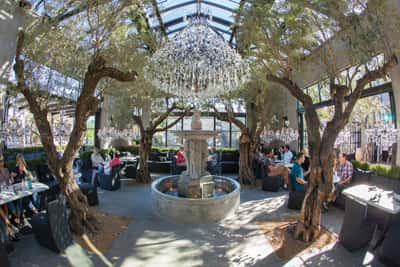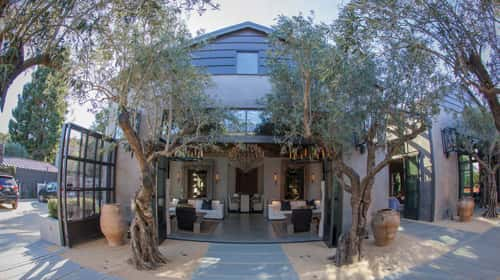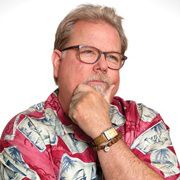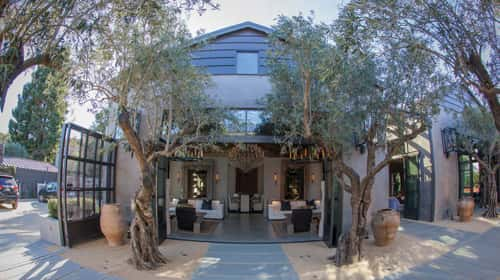U.S. brick-and-mortar retailers are in retreat. Pier 1 Imports is planning on closing more than 140 stores and Z Gallery is shuttering 44 locations. Sears filed for bankruptcy, joining Gymboree and Payless Shoes.
Closure of retail stores across the country hit a 10-year high in 2018, according to Citylab.
Don’t bring this to RH chairman and CEO Gary Friedman, “The death of retail is overrated,” he told shoppers in September 2018 in one of his famed letters. The brand formerly known as Restoration Hardware has its own language. Catalogs are Source Books. Stores are Galleries. And RH has more Collections than the Smithsonian.
And the chain looking to make sumptuousness more mainstream is opening new galleries. There’s one going into Corte Madera’s The Village and another already built in Yountville. That 18,000-square-foot complex includes a glass-roofed restaurant, a two-story wine vault, 100-year-old olive trees and a pair of boutique design galleries.
That description, however, falls woefully short. More from Friedman: “We create inspiring spaces that blur the lines between residential and retail, indoors and outdoors. Spaces that are more home than store. Spaces that are filled with fresh air and natural light, with garden courtyards, rooftop parks, restaurants, wine vaults and barista bars. Spaces that are an integration of food, wine, art and design. Spaces that activate all of the senses, and spaces that cannot be replicated online.”
Indeed, it may seem like Friedman is trying to conquer Space without the booster rocket, but give him credit, he has RH in a rare orbit. For the quarter ending Aug. 3, 2019, the company posted $706.5 million in revenues and had $71.4 million in adjusted net income. The company posted an adjusted earnings per share of $3.20. These are the kinds of numbers that make analysts swear off Viagra.
Standing retail on Its head
In a sector that’s consolidating—and in some cases closing up shop—those are pretty interesting numbers. They become more noteworthy when you consider that RH is spending cash to grow, and it wants to open seven new galleries a year. The company is also selling its goods at the top of the market to a clientele that doesn’t think a couch that comes in six different lengths and 245 different leathers is maybe a little over the top.
The new store in Corte Madera will be a separate structure from the rest of the shopping center, essentially built in the parking lot away from the rest of the mall. This is also symbolic of how RH sees itself in relation to other retailers—separate, isolated, not of this world.
 The nearly 60,000-square-foot building with indoor-outdoor space will be three stories, with a restaurant on the top floor offering 360-degree views. The new place will have a Wine & Barista Bar as well. The current store is only 8,800 square feet, so that gives you a sense of its scale. The construction is well under way and the goal is to have it open by early 2020.
The nearly 60,000-square-foot building with indoor-outdoor space will be three stories, with a restaurant on the top floor offering 360-degree views. The new place will have a Wine & Barista Bar as well. The current store is only 8,800 square feet, so that gives you a sense of its scale. The construction is well under way and the goal is to have it open by early 2020.
But the new Corte Madera store is a dollhouse compared to RH’s outpost in New York’s meatpacking district. The 90,000-square-foot gallery opened in September of last year with six floors, a glass elevator and a rooftop restaurant. And Friedman has said he thinks the New York store will be the first gallery to hit $100 million in annual sales in a Forbes Magazine piece in September 2018.
All told, RH has 70 stores and 39 outlets as well as the brands RH Modern, RH Beach House, RH Baby & Child, RH Teen and RH Interior Design. But only 22 design galleries, the models RH sees conquering the world, have been built. You can find those emporiums to extravagance in such far-flung locales as West Hollywood and Edina, Minn., as well as Chicago, Boston, Nashville, West Palm Beach, Fla., and Toronto.
The 4,900-employee company command center sits over on Koch Road in Corte Madera, an unlikely location from which to conquer the world, but nevertheless that is HQ. The company was founded in 1980 by Steven Gordon, who was restoring a Victorian in Eureka. Legend has it that Gordon was disappointed with fixtures and door knobs that he ran across as he tried to stay loyal to design of a bygone era. He founded a chain based on the notion that there was nothing wrong with paying attention to detail and longing for days past.
The stores became well known for vintage reproductions and for the holidays, which were filled with nostalgia items appealing to Baby Boomers looking to stuff stockings with $5 yo-yos and mini-board games.
Full disclosure, we own chrome-encased penguins from RH, purchased way back when it was still known as Restoration Hardware, as well as a cocktail shaker. But they were purchased at full price, and no animals were harmed in the sale of the goods.
But Restoration Hardware grew too quickly, swelling to 100 stores before Gordon left in 2005, to head up Robert Redford’s Sundance business. By that time, Friedman had been there just under four years. In the quarterly investor call in September, he recalled those days with less than a happy nostalgia. “We’re finally getting rid of the last of holiday. Remember when we were in all those shitty seasonal businesses? We used to sell Halloween crap, and we used to sell Easter crap and we used to sell Valentine’s crap.”
That call went on for better than two hours as Friedman regaled analysts and investors with tales of a recent trip to scout Europe for retail locations as well as holding forth on his vision for RH. I cover public companies for a living, which means I listen to more of these calls than is healthy for a human. But every company that does them has the same goal: A) Impart the public information; B) Spin when you must; C) Answer as few questions as possible; and D) Get the hell off the phone.
Friedman is different. He has something to say. The company has a link on its website to the letters he writes for each source book, kind of a little library of his 31 dispatches.
So, it’s ironic that RH did not make the talkative Friedman available for this story. They did say they were sorry. It’s really too bad because Friedman is a guy you want to interview, chatty, smart, speaks his mind. At any rate, we have chased down some of his words shared with others.
Friedman=RH
It’s not unusual to have a CEO create a company’s vision, nor is it unheard of for a CEO to be the driving force behind the company. Friedman’s influence goes deeper. Anthony Chukumba, an analyst for Loop Capital Markets told Forbes, “A lot of people have lost a lot of money betting against Gary Friedman. If Gary is hit by a bus, sell the stock and look back later.”
Friedman has RH moving up in a down market, not an easy thing. President Trump lobbed China tariffs into the mix, which should have started RH bleeding, as it has sourcing centers in Shanghai and Hong Kong. Instead, RH wrestled with costs, received some concessions from its suppliers, and for the most part held the line on prices. Granted, those prices include a ceiling fan for $900 and a faucet set with a price tag starting at $800.
Friedman’s brash confidence in building an extravagant brand is far removed from his roots in San Francisco and later Santa Rosa. He lost his father when he was 5 and was raised by his mother, Angela, who suffered from bipolar schizophrenia. The family moved around a lot—16 times before he turned 18. Gary started at The Gap after high school, while enrolled at Santa Rosa Junior College. He moved up the ladder—stock boy to salesperson, assistant manager, store manager, district manager and to regional manager, excelling at leadership and visual merchandising. This got the attention of then-CEO Mickey Drexler. He rose through the ranks of the clothing retailer until he left for William-Sonoma, Inc. and Pottery Barn. But when a management shuffle didn’t land him in the William Sonoma, Inc. CEO post, he was gone, departing to Restoration Hardware, a chain he considered buying while he was the president of Williams Sonoma, Inc. and their portfolio of brands, including Pottery Barn and West Elm, which he started.
Resto, as it was known to those inside the company and locals, needed a life-saving turnaround as founder Steven Gordon had grown the company too big and too fast, its stock traveling from $37 a share down to 50 cents.
When Gordon stepped down as CEO in 2001, Friedman had been on simmer for just under four years. With the kitchen more to his liking, he changed the menu. He began implementing his brand, bringing in linens, furniture and lighting. But three years later the economy tanked as did the housing market, a not so insignificant event for a home furnishings chain. Friedman made a multi-million dollar personal investment and teamed with Catterton Partners and Tower Three Partners in taking the company private, slicing the costs of being a public company out and silencing the voices on Wall Street shouting about how the company should be run.
 In 2008, Friedman began building his company into an upscale retailer for those who wanted finer furnishings and didn’t mind spending some cash to have them. The retail world shook its head and waited for the chain to implode. Wall Street questioned the pace of change as well as the move to posh, while most retailers were simply trying to hang on.
In 2008, Friedman began building his company into an upscale retailer for those who wanted finer furnishings and didn’t mind spending some cash to have them. The retail world shook its head and waited for the chain to implode. Wall Street questioned the pace of change as well as the move to posh, while most retailers were simply trying to hang on.
More from Friedman in a 2011 Wall Street Journal article: “In 2008, it wasn’t clear whether we were going to make it,” says Friedman…Rather than hedging, he says, the company doubled down. “We said, ‘Let’s forget about the customer for a minute.’ I don’t mean that in an arrogant way. We believe that great brands don’t chase customers, customers chase great brands. While everybody was “screaming value,” Restoration went the other direction. “In bad economic times,” argues Friedman, “quality becomes even more important, uniqueness becomes even more important—people need to be inspired to buy something.”
Things got rough for Friedman in 2012. Three months before the company went public, his relationship with a 26-year-old company employee began causing problems. Not wanting to hold up the IPO, Friedman and the board decided he should fade into the background. He stepped down from his CEO title and took the posts of chairman emeritus, creator and curator. A year later he assumed his CEO duties.
The life imagined…
RH created a brand that takes furnishing an abode to a completely different level and did so at a time when home sales have slumped. It caters to a clientele that is limited and its idea of success is building stores that are huge, opulent and getting you to consider a five figure (or maybe six figure) furnishing budget while you throw down a $24 burger. “RH is a curator of design, taste and style in the luxury lifestyle market,” according to the company website.
The thing to understand about RH is they don’t believe in having sales. Your TV might blow up over a holiday weekend with ads from furniture chains advertising sales of 25 percent off, but walk through RH and you will see the same old tags.
In a September 2018 shareholder letter, Friedman summed up the RH formula this way, “The road of endless promotions, free shipping, and a shrinking store base is resulting in broken and unsustainable retail models. We prefer the road less traveled by, and like Robert Frost, believe it will make all the difference.”
This is not to say that the company doesn’t discount, it just does so Costco style, kind of. RH offers its customers perks, but to get in on the pricing, you need to be a member. So, like American Express always advised, membership has its privileges. This membership will set you back one Benjamin Franklin a year. But being in the club gets you 25 percent every day, and when sales do happen, you get 20 percent off that tag. Members also get comp services with RH Interior Design and early notice of clearance events.
The New York Times reports that 95 percent of the company’s business is now driven by members, which includes more than 400,000 souls. If that’s the case, it would seem that RH needs to not only sell furniture but sell memberships too.
So. RH has a contrarian outlook on how best to build a business. Or, as my old boss Jim Cramer put it on his show Mad Money, “RH is a market disruptor, often to the point that it disrupts itself."
Friedman explains his company’s disruption this way, “It wasn’t the Internet that killed retail stores; it was a lack of imagination and investment.” That’s what he told Architectural Digest in a fall 2018 story.
While much of the RH story belongs to Friedman, there are nearly 5,000 employees carrying forward both his vision and his marching orders. Every new employee is handed a two-page document with the company’s vision, values, and beliefs that are part mission statement, part operating instructions, part fighting words.
Whether it’s the rules or Friedman’s vision or the path less taken, it’s working. BofA Merrill Lynch Global Research upgraded Resto’s stock to a buy and set the target price at $200, a far cry from the 50 cent shares when the shares were bankruptcy bait. In mid-October, at the time of this writing, shares traded on the New York Stock Exchange at $185.21.
 One of the key ways RH plans to grow is by expanding overseas. In the last investor call, Friedman talked about the European market with the kind of enthusiasm an 8-year-old brings to Baskin Robbins. Keep in mind, that thus far RH hasn’t designated the location of the first gallery, but Friedman is already declaring that going international could morph the Corte Madera company into a $15 billion Goliath, and roll up its share price into very rarefied air, “I think people are going to look at RH, whatever it’s trading at today, $150, $160 a share—10 years from now, the stock could be $1,600 a share.”
One of the key ways RH plans to grow is by expanding overseas. In the last investor call, Friedman talked about the European market with the kind of enthusiasm an 8-year-old brings to Baskin Robbins. Keep in mind, that thus far RH hasn’t designated the location of the first gallery, but Friedman is already declaring that going international could morph the Corte Madera company into a $15 billion Goliath, and roll up its share price into very rarefied air, “I think people are going to look at RH, whatever it’s trading at today, $150, $160 a share—10 years from now, the stock could be $1,600 a share.”
That is the gated community where Google and Amazon shares live.
And while the new galleries include more than a nod to hospitality with wine vaults, coffee bars and restaurants, there is yet another piece of the RH profit puzzle.
Friedman wants to extend the RH brand to hotels. The company will open its first boutique hotel RH Guesthouse in New York on Gansevoort Street. Another is said to be planned for Aspen, Colo.
RH Interiors Design isn’t being left out of the growth equation. The brand is responsible for the design of Gwyneth Paltrow’s Goop company offices at the Santa Monica headquarters.
All these RH growth undertakings require two basic things, Friedman and cash. They require much more than that of course, like an economy that continues to move forward and for RH to continue to be cool.
And though the RH Rules cover the cool part, not everyone is one “of our people.”
Friedman and RH are growing at a time of constriction and consolidation in the furniture world, not an easy thing. But at some point, the merry-go-round that is RH is bound to slow, and that too will be interesting to watch.
With that in mind, the last line of RH Rules fits here: “On Team RH, Fast is as Slow as we Go.”
Author
-

Bill Meagher is a contributing editor at NorthBay biz magazine. He is also a senior editor for The Deal, a Manhattan-based digital financial news outlet where he covers alternative investment, micro and smallcap equity finance, and the intersection of cannabis and institutional investment. He also does investigative reporting. He can be reached with news tips and legal threats at bmeagher@northbaybiz.com.
View all posts




